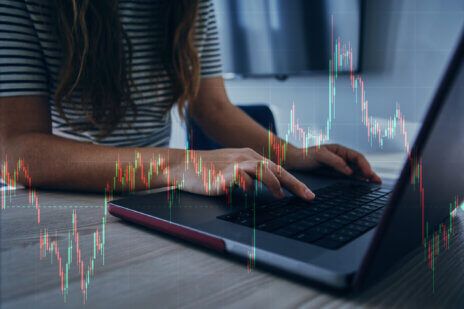
Thornburg’s CPMs discuss the case for active investment management amid heightened uncertainty, macro pressures, and interest rate volatility.
Active Investing in a Passive World
Josh Rubin: This is the CPM round table, where Thornburg client portfolio managers will discuss topics that are top of mind for investors. My name is Josh Rubin and I’m joined by Phil Gronniger and Ben Keating. And as client portfolio managers, we are engaged daily with both the investment team and clients, which gives us a unique insight into what’s top of mind. Last time, we spoke about some of the dislocations in macro trends and the overall state of the fixed income market. Today, we’ll talk about why, in these choppy markets or some of the uncertainty, there can be benefits of active investment management. In our last discussion, it just it jogged my thinking when you mentioned TINA, which also we probably haven’t heard about TINA, since the 2010s. But that and then it came back a little bit during Covid, but that was a period that passive investing really took off. And it was because the Fed had declared there was no alternative. Mario Draghi had declared he was going to use whatever bazooka he needed to. And so, it was really easy, even though the market was sort of narrow, by participation, if you shifted into passive, you could participate in whatever rising tide was generated by central banks. And then it sort of became the self-reinforcing cycle, where larger market cap companies kept getting more of those passive flows and just becoming larger without real differentiation of fundamentals or valuation construct that active investors would have.
But, you know, both on the equity side or on the fixed income side, do you guys see certain markets again, rather regionally, or asset classes where active management can make a bigger difference or a bigger impact right now, or take advantage of some bigger dislocations today or, you know, is active management just as hard as it’s always been? But also, equally, there’s an equal opportunity kind of anywhere you look right now.
Ben Keating: Yeah, I mean, I’ll certainly chime in on the fixed income side, a lot of us have extensive fixed income background, it’s a different animal. I get the excitement, or the draw, of indexing – low-cost replication of an index, and that has applications on the equity side. You can see transparency, and these are well-run companies obviously more maybe bad companies will fly out of the index. Just look at the mechanics of bonds. It just sets the wrong table. Indexing in the bond market, the bigger debtor you are, the bigger part of the index you are. So, the whole idea of being benchmark driven is, I think, flawed in the fixed income. And oh, by the way, the AGG is seen as the benchmark in fixed income. Good luck trying to recreate that benchmark. I think there’s 10,000 individual CUSIPs so you can’t do it. It’s just not possible, and I wouldn’t recommend you do it. And then just the edge that active has over passive in fixed income, especially if you think you’re later stage talked about tight spreads. God forbid there is a recession. You know there’s going to be an expected carnage illiquidity that you want to just have a really steady hand over, managing that aspect. And just last point on active, what’s really changed is the ability to do it some multi-sector credit, I think, is a really unique way of doing it. In what used to take out, you know, the trend 20 years ago may have played out over 7 or 9 months today because of so many people involved. That same trying to take out over seven, nine trading days. So, the timing of trying to take advantage of a particular, impactful or disjoint-ment in the market is much, much faster. And so those are important things. I think the case for active has always been there. But it’s certainly, I think, more pronounced now as you head into perhaps a slow recovery.
Phil Gronniger: Adding on to that, Ben mentioned the US AGG. You think about the construct of most fixed income indices, and I’ll pick on the AGG here in a moment. They’re really poor proxies really for risk and reward. If you want to compare, an investment to something because they emit a tremendous amount of securities and going back to the AGG, the AGG has had a interest rate sensitivity.
The duration has gone up and up and up over the years, and it’s highly sensitive to changes in interest rates. So, when rates go up, prices generally go down. And fixed income, there’s ways to mitigate that. But you’re going along for the ride with higher and higher interest rate sensitivity. At a time when, take 2022 for example, it was very painful when the Fed raised rates, is the worst year ever for the U.S AGG, which goes back to 1976. Prior to 22, the worst year in the AGG was down 2.94%, and 1994 is about 13% in 2022. So going back to the AGG, the AGG only has about 26% and investment grade corporate bonds. It omits high yield. Low triple B rating is considered a high yield or below investment grade. Used to be called junk. I think someone in marketing long ago said it’s really hard to sell junk, let’s change the name what’s called high yield. That sounds much better for investors. So, they changed the name to know because they’re paying a higher coupon. But these can be great companies that maybe have a little extra leverage on their balance sheet. If their business is doing really well, perhaps they’re deleveraging. They’re going from a single B to a double B from a double B, and they’re making their way to an investment grade rate in triple B, they’ll jump into the index at that point there can be a great price appreciation opportunity as a company deleverages is over time. So just on the corporate side, again omitting a significant part of an opportunity set and doing your fundamental research, bottom up fundamental research to uncover opportunity that’s going to be missed potentially in a passive that’s trying to replicate something like the AGG. And then securitized, so the AGG has about roughly 30% in agency mortgage-backed securities, zero and not agency mortgages. So non-agency mortgages something that’s not Fannie, Freddie or Jenny. And it can be a great borrower purchasing a home. Perhaps it’s a second home or someone that doesn’t generate a W-2 and they’re self-employed might have a great personal business but they’re not agency mortgage.
So those are not in the index. Or if you look at the CMBS or ABS space, they’re very limited and they’re very small in representation within a passive investment that’s trying to replicate the AGG. And Ben mentioned the opportunities there that one could have investing outside of, if you will, just those indices where you can deliver and say a multi-sector strategy much more potential if you will return upside and then go back to that rate sensitivity, adjusting the rate sensitivity of the fixed income portfolio can have very meaningful implications as well. Post-2022, after the big rate jump, a lot of investors thought, hey, now’s a great time to buy long bonds because it was at the end of 2013 the reality a tantrum in the ten year and the 30-year we’re at year three and 4% each. The 30-year Treasury had a fantastic return in 2014. It was up over, I think it was over 30%. Some people forecasted that to happen again because rates have gone up so much. Betting long in maturities and long and duration has been relatively painful if you’re a fixed income investor. And when I say long, I’m talking going out 6-to-10-year part in terms of the duration. Playing it on more of the sweet spot on the yield curve in duration in that 2 to 4 range has been very beneficial for fixed income investors, as rates have continued to rise, since September of last year.
Josh Rubin: You know, a funny thing about index construction is that it really reflects past success or past actions rather than the future. And, you know, you see it in different ways in equities versus fixed income indices, but sort of, Phil, you know, your mention of what the AGG looks like. And by being by running a larger deficit and making our fiscal future more complicated, the US becomes a bigger part of the AGG. So actually, you know, the longer a country runs a higher deficit, the bigger it becomes a part of its, you know, respect to fixed income market, which is not normally the way you would think about, having an index that actually reflects rising risk rather than, you know, rising opportunities, so to speak. But in the same way, we certainly know take the last 40 or 50 years of the S&P 500 or Dow and the largest companies from a decade or two decades ago often are no longer in the top 10 or 20 just because there’s disruption and so on. That’s what we’ve seen with the Mag 7, which may all be magnificent, but everybody’s forgotten, I think. I can’t speak if it’s exactly true today, but if you look at the returns in the share price for Domino’s Pizza and Google, since Google became public, they’re about the same. Google has had a bigger participation in the index, but if you were a SMID Cap investor owning Domino’s, you weren’t too sad about it. Or if you were an All-Cap investor owning Domino’s, you weren’t too sad about it. And so, there’s a lot of opportunities like that that don’t just reflect the index construction, but broader opportunities.
Phil Gronniger: It takes it to the equity side of things, when you think about that. We’ve touched on a lot on the fixed income side, but having active share in the equity market and a differentiated view and going along for the ride in an index, and don’t get me wrong, just owning that index might be great for some investors. But the ability to outperform through active, bottom up fundamental research and looking, if you will, different than the index making active decisions to invest in companies that whether they’re boring and beautiful, paying a great dividend that you’ll get you through different times, or it’s a move maybe a little more growth oriented company that can have differentiation from the index. It’s a fantastic way to compound wealth long term for investors as well.
Ben Keating: Yeah. The case for international markets, for active management and equities is still alive and well. I think it’s more pronounced on the fixed income perhaps, but especially when you’re talking about international stocks. I mean, people forget even in developed markets, take Japan for example, very parochial market. You got to have boots on the ground. You can understand how financial statements are released. It’s not quite the same American standard of accounting or for earnings results. And little nuances like that affect your ability to access companies in that theater. It’s becoming better, you know, emerging markets. But it’s not nearly to the same transparency level of American system.
So that is an advantage for active investing. You can scale out that, get your own information, judge the risk appropriately. I have high active share, like Phil mentioned, there’s a really good benefit to that. And then another point on international, it does feel as if another reason why people were cynical on international equities was you don’t only perhaps lagged U.S performance, but you didn’t seemingly get the correlation benefits. You know, another real benefit of going overseas is seemingly getting lower correlation risk to the US that seem to be off. It does feel like historical correlations are coming back again and you’re starting to see, you know, different theaters, different people, funding rates, people raising rates. You’re obviously we talked about deglobalization, supply chains, all of that factors into perhaps better correlation benefits by going overseas.
Josh Rubin: That is, I mean one other balance would be the U.S. is the most developed capital market in the world, the deepest, you know, the broadest and so on. So, we have a zillion ETFs. And you know we have a zillion passive, thematic take your pick. But somewhat because of economics, somewhat because of local regulatory oversight or trading frictions, there’s a lot fewer ETFs for accessing international markets. And so it can be, you know, if you’re excited about a hot dot in the US, maybe you can buy a passive ETF for that. But if you’re excited about, you know, opportunities in international, stock pickers are more relevant because there just isn’t the same ETF availability aside from, you know, just a more opaque environment because of reporting disclosures. You know, in Europe, half the companies only report twice a year, not every quarter. So information flow is not, you know, daily or weekly. You need to have a different kind of view for it. I guess Ben one of the things that comes to mind just on your comment about, correlations you know maybe returning to normal, is even with passives impact. I think what we see, you know, there’s a lot of data proving this that correlations are higher the shorter term your investment horizon is and so it really is over the medium-to-long term that company fundamentals or the valuation starting point you know matters in generating a different outcome. But partially because of passive flows, a lot of stocks behave similarly over one month or even over 6 or 12 months.
But then it’s year two, year three when you get a difference in the corporate management, the company execution, often even the dividend strategy, right? If you take three years where one company pays a 3% yield and one pays a 5% yield, suddenly does start to add up that total return differential. But there’s a lot of moving pieces to correlations besides, just, do the ETFs behave in one way this week or this month?
Ben Keating: I totally agree, I mean, I wish there was some magic bullet. Don’t go to one theater. You get the returns, get the diversification. It doesn’t work that way. You know, you have to put the work in. So yeah, it just it does feel like it’s the right time. You’re seeing people that are you know, shortfall if they’ve left the allocation to international equities slide for various reasons over several decades, perhaps it does feel like things are starting to at least close that gap, get more of a neutral value of cases. Want to be overweight and who knows. I just think it’s going to be an interesting year.
But again, it’s hopefully what conveys is mostly incredibly positive things are occurring. Just a remarkable global economy. We’ve been tested and we’ve kind of held in there amazingly. And there’s a lot of other side things that we can be excited about. But just yeah, just an amazing backdrop.
Josh Rubin: Maybe one other topic. Which is really asking you two about topic. You two have been on the road meeting with, both prospects and existing Thornburg investors, more recently. Do you feel there are any other notable themes or kind of key questions that are on people’s minds that that we haven’t touched on?
Phil Gronniger: I didn’t get the question. Have I missed my opportunity? You know, I say with a resounding no. I think the most important part about investing is it’s a long-term thing. It’s about time in the market and not timing the market. So, markets are going to go up and down over, over months, quarters, weeks, years. So, being in the market and participating in the market and making incremental adjustments on an allocation through one financial advisor, or for those that are doing it on their own, but avoiding, if you will, the fear and greed that can drive people in and out of the markets and trying to time things.
I think that’s one of the keys that, conversations I’ve been having, whether it’s fixed income or equity.
Ben Keating: Yeah, it’s more, I guess, the psychology of investing. I think to the extent it’s not just your teenage daughter or son that seems to be fixed in your on your iPhones and not as social as they perhaps should be, some financial advisors have let that so that they are not as in tune with their wholesalers or other advisors. They’ve kind of been in their own world. They’re coming up for air. They’re, they’re seeing perhaps some changes going on. So I just think the ability to have conversations, in person to person, knee to knee, there’s a pretty big appetite for that. I think maybe it’s remnants of being Covid shutdowns. And a lot of people are fearful that they’re missing out, that they’ve got a handle on their own world, that perhaps there’s something greener pastures elsewhere, that that some other advisor or some other team is doing. So it’s always helpful to have that dialog. Kinda we’re all in this together. But I just again, if you can’t have incredible optimism about what’s before you turn out to be amazing, time to be alive investor, incredible innovation, incredible globalization, productivity gains are likely. And recently threats that would have really dragged down the markets. The markets have kind of just take it in stride, which is very telling. If there was a real problem. You would see way more fear and way more question. And again, things, things can change. But I think to keep this as a really good stage of investing.
It does, it feels like it’s hard to be late. Right? You know that the major trade that’s long in the tooth is 0% interest rates, but just about everything has sort of been going through this process of reset, somewhat rising interest rates change the cost of capital somewhat. There was a shock from Russia, Ukraine, but now both corporates or economies or politics have kind of rebalance to that. And also we’re still early enough in the uncertainty of US trade policy or economic policy that there’s nothing that’s really lasted longer than you would expect. And typically, we’ve seen, you know, value leads the market for several years or international leads the US for several years. And so, we’ve got a few different trades going on around the world, but none of them have been, multiyear trends other than, you know, quote unquote, U.S exceptionalism for 15 years, largely of 0% interest rate policy.
Josh Rubin: Phil and Ben, this has been a great conversation. A lot of topics that have long shelf lives, some of them are more tactical, but a lot of things to talk about, and we’ll do this again sometime soon.
Important Information
The views expressed are subject to change and do not necessarily reflect the views of Thornburg Investment Management, Inc. This document is for informational purposes only and does not constitute a recommendation or investment advice and is not intended to predict the performance of any investment or market. It should not be construed as advice as to the investing in or the buying or selling of securities, or as an activity in furtherance of a trade in securities.
This is not a solicitation or offer for any product or service or an offer or solicitation for the purchase or sale of any financial instrument, product or service sponsored by Thornburg or its affiliates. Nor is it a complete analysis of every material fact concerning any market, industry, or investment. Data has been obtained from sources considered reliable, but Thornburg makes no representations as to the completeness or accuracy of such information and has no obligation to provide updates or changes. Thornburg does not accept any responsibility and cannot be held liable for any person’s use of or reliance on the information and opinions contained herein. The views expressed herein may change at any time after the date of this publication. There is no guarantee that any projection, forecast or opinion in this material will be realized.
Investments carry risks, including possible loss of principal.
More Insights

FOMC Update: Fed Approves Third Consecutive Rate Cut, Projects Slower Pace

Luxury Brands Navigate China Slowdown and Tariff Pressures

Thornburg Investment Income Builder Fund – 4th Quarter Update 2025

Extract Maximum Income Using Active Management

Investment Perspectives from the Road: European Luxury Goods



